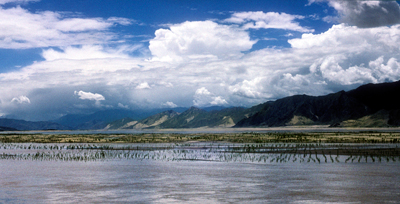Rushing water is strangely refreshing and attractive, and for this reason hikers often sit beside rivers and streams to enjoy the eternal movement and relaxing sound of flowing water. If scenes such as this are photographed using a relatively high shutter speed, perhaps 1/125 sec, the movement of the water is more or less frozen and much of the enjoyable human experience is removed from the image.
 The flow of a river can be effectively conveyed to the viewer by using a slow shutter speed to blur the movement of the water. Choice of the optimum shutter speed is important and determined by the speed of flow of the water. For a fast flowing torrent a speed of 1/15sec might be sufficient to record blur. For slower rivers, it may be necessary to select a speed of ½ sec or even 1 sec. The longer the shutter speed the greater the smoothing effect recorded in the water. The camera must be mounted on a tripod to ensure that the rest of the scene is rendered sharp.
The flow of a river can be effectively conveyed to the viewer by using a slow shutter speed to blur the movement of the water. Choice of the optimum shutter speed is important and determined by the speed of flow of the water. For a fast flowing torrent a speed of 1/15sec might be sufficient to record blur. For slower rivers, it may be necessary to select a speed of ½ sec or even 1 sec. The longer the shutter speed the greater the smoothing effect recorded in the water. The camera must be mounted on a tripod to ensure that the rest of the scene is rendered sharp.
An alternative approach is to use a fast shutter speed, perhaps 1/500 sec, to freeze every drop of glistening water as it explodes over rocks and stones. Each droplet catches direct sunlight and glistens as it flies through the air. A camera placed low down close to the level of the water adds power by giving the impression of water about to burst out of the image. A polarizing filter reduces reflections from the surfaces of wet rocks and consequently intensifies the beautiful natural colours.
The direction of flow of water through an image is an important element of composition. Consider carefully where the water enters and leaves the image and consider making use of diagonal lines. They are more interesting than horizontal of vertical lines, and consequently have more impact. If the water enters or leaves the image at a corner the composition may work better.






